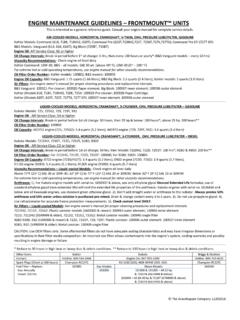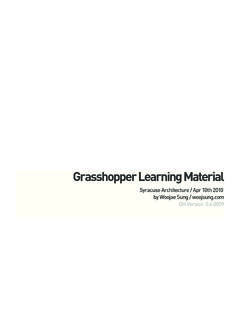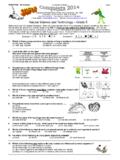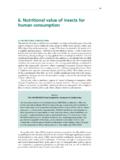Transcription of Rhino|Grasshopper|Tutorial
1 rhino | rhino | grasshopper |TutorialIvo A. Semerdjiev The purpose of this tutorial is to create a folding origami skin based on parametric principles. The first step is to make a square grided surface based on one convex and concave curves. Their z-axis planars are aligned and then arrayed. The second step is to use data structures in order to get access to every point on the surface. The third step is to create the vectors and the line segments defined by start point, tangent and length which will follow the direction of the folding surfaces. The last step is to connect all the end points of the vectors to create the surfaces for an uniform folding + the option to creat an attracting point which would dictate a non-uniform ++ Draw two curves in Rhinorecors - one should be the the base curve and the other one the profile curve . it does not matter what kind of curves you are drawing - as long as they are perpendicular to each other.
2 ++ Connect grasshopper and rhino objects.++ From the Curve toolbar > Analysis > select Planar - to test the profile curve for planarity. at its end, you will see a plane which is parallel to the ++ From the Vector toolbar > Plane > select Align plane to perform minimal rotation in order to align a plane with a guide vector the plane before was parallel to the curve, but it was not parallel to a vector in the Z-axis.++ Select from the Vector toolbar > Constants > Unit Z [vector in a Z direction]++ From the Curve toolbar > Utilities > choose Flip If more than 50% of the base curve orientation is anti-parallel to the profile curve, the base curve is flipped and the flip action is set to no guide is provided, the curve is always flipped.++ Again from the Curve toolbar > Division > select Pframes (perpendicular frames) + + Assign a slider to [N - number of segments], which will be the amount of the frames on the base curve.
3 PFrames - generate a number of equally spaced, perpendicular frames along a ++ Select the XForm toolbar > Euclidian > Orient Orient - Orientation is sometimes called a ChangeBasis tranformation . It allows for remapping of geometry from one axis-system to another.++ From the Params toolbar > Geometry > Point Point - Represents a list of 3D Point coordinates. + + Select Curve toolbar > Spline > PLine [poly line] PLine - Create a polyline connecting a number of ++ Choose Logic toolbar > Sets > Cull Pattern ; right click on [boolean parameter] > manage boolean collection Cull (remove) elements in a list using a repeating bit mask [like the chess board]. The bit mask is defined as a list of Boolean values. The bit mask is repeated until all elements in the data list have been evaluated. Select the Cull parameter and you will see several green and red pairs of points - due to the fact that in the boolean manager we have [false,false,true,true].
4 ++ Delete the command in the boolean manager and type [false, true] Now we have every other point to be green and ++ Select another Cull Pattern parameter, but this time in the boolean manager type [True,False] This how we will be able to seperate everypoint from its neighbors and to be in a diffrent group.++Choose from the Vector toolbar > Point > Distance Distance - Compute the distance between two point coordinates.++From the Params toolbar > Special > Panel - the numbers in the panel represent the distance between the points on the base curve. Panels can also receive their information from elsewhere. If you plug an output parameter into a Panel, you can see the contents of that parameter in realtime. All data in grasshopper can be viewed in this way. You are able to see all the data behind every ++ Since our profile curves have been assigned to the perpendiculat frames on the base curve - the number of the frames will dictate the dencity of the origami surface.
5 ++ Select from the Curve toolbar > Division > DivLenght [Divide Lenght] DivLenght - Divide a curve into segments with a preset length++ You can see how the profile curves are divided by the same distance lenght numbers in the yellow ++ The more we increase slider s number, more points are dividing the profile curves. + + The numbers in the panel are decreasing which is telling us that the vertical curves are devided by points with smaller distance It is good, when we are modeling in grasshopper , not to keep the dencity of the surface too big in order not to slow down our modeling process.++ Keeping in mind all the information so far we are going to enter into the second part of this tutorial where we will start working with data ++ From the Logic toolbar > List > Shift List [Shift] Shift List - Items in the list are moved towards the start and the end of a list if the shift offset is positive or negative.
6 ++ Create two Shift components, connect them with the Divide Lenght, and set their integers to [1] and [-1].++ Select from the Param toolbar > Special > Param Viewer [data tree structure] Param Viewer can store in hierarchical structures similar to a branching tree. Data is still stored in lists, but each list now has a path , which is a series of indices that describe the position of the data branch inside the tree.++ The top Param Viewer shows the data structure graphically, the bottom one as a list. To switch between the two modes - double click on the ++ Choose the Logic toolbar > List > Shift List [Shift]++ Create four Shift components, connect them with the Param Viewers, and set their integers to [1] and [-1] as two pairs. The Shift components will either move the lists up or down a number of increments dependent on the value of the shift offset.
7 ++ Select from the Logic toolbar > Tree > Branch [Tree Branch] The Branch gives us a specific branch from the data tree. Elements in a list are identified by their index number. This component allows you to have an access to a single item or a group of items from a list by index.+ + Connect the two branches with the first Param Viewer group components and renamed them Branch_1 and Branch 2 for an easier access later on in the ++ Do the same procedure for the bottom group of the Param Viewer.++ Rename the two new branches: Branch_3 and Branch_4 The reason why our branches are connected to the Shift List at the begging is because those list s are our original data structure of our points. The Param Viewer is giving us a complete control over all item and last but not least it is has a better graphic representation of the stored information.++ From the Curve toolbar > Primitive > Line+ + Connect it with the first two Shift components which represent the begging of the data structures.
8 The line parameter will substitute the curves and will give us the straight profile polylines, which will surve us as the basic frames of the origami ++ Select from the Curve toolbar > Analisys > Evaluate Curve Evaluate Curve - will evaluate each curve at a specific parameter. If the lenght of a single curve is 1 and the parameter is , it will mark [make a point] at the middle of the curve. if it is , the point will be at 1/4 of the curve, and so on. + + Set the parameter at , right click on [C] and select [Reparametarize] - Reparameterize changes the curves to have a domain from zero to one.++ To get a full access to all middle points of the vertical profile curves - choose the Param toolbar > Special > Param Viewer++ Add two more Shift List components with their [1] and [-1] integers ++ Choose from the Logic toolbar > Tree > Tree Branch++ Connect them to the Evaluate Curve component, where are stored our middle points of the vertical profile curves and rename them to Branch_5 and Branch_6 ++ We have to create horizontal polylines through the original first points of the surface.
9 ++ The last Param Viewer and the pair of Shift List components we must connect to the old Divide Lenght parameter in order to gain control over those points. ++ Assign the last two Branch Tree components to the Shift Lists and the Divide Lenght parameter - where are all the original points on the surface.++ Rename them - Branch_7 and Branch_8 for an easier navigation in the following steps.++ Select from the Curve toolbar > Primitive > Line++ Connect it to Branch_7 and Branch_8 to create the horizontal straight polylines of the origamy ++ From the Curve toolbar > Analisys > Evaluate Curve Will give us the mid-points of the newly made horizontal curves. + + Set the parameter number at [t] to , right click on [C] and select [Reparametarize] to changes the domain of the curve from zero to one.++ The next step will be to get the vertical and horizontal polylines through all the mid-points of the curves.
10 ++ Choose from the Logic toolbar > List > Shift List - assign their positive and negative number [1] and [-1] and connect them to the Evaluate Curve ++ Select the Curve toolbar > Primitive > Line++ Assigned it to the both Shift List components and we will get the vertical curves through the middle points of the horizontal polylines.++ From the Curve toolbar > Analisys > Evaluate Curve Set the parameter number at [t] to , right click on [C] and select [Reparametarize] to changes the domain of the curve from zero to one.++ By evaluating the middle vertical lines, we would be able to reach their middle points which will serve us as a base list for creating the middle horizontal lines. It is good to rename the component to [Eval / central_point], because these points are going to be very important for the rest of the grasshopper ++ Choose the Curve toolbar > Primitive > Line++ Connect it to the both Shift List components and we will get the horizontal curves through the middle points of the middle vertical ++ By the end of the second part we should have a surface that will cointain all of its main vertical and horizontal lines and and those lines which are going through the mid point of all of them.






